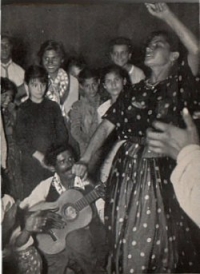Villancicos
Villancicos from the film Flamenco
During this holiday season I do my best to avoid shopping malls and other places Christmas music is played. The treacly-ness of Christmas standards makes my skin crawl. However, there is a kind of Christmas music I do find enjoyable and that is Villancicos Flamencos. I first heard this kind of villancicos in the Carlos Saura film Flamenco and was struck by it’s percussive elements, in particular, the pulsing bass. In the above clip the sound is produced by an instrument called a zambomba – a barrel or jug covered by an animal hide through which the player moves a cane in rhythm with the song. In the clip below, the bass sound is made by passing a hand over a large clay jug. Other instruments commonly used in villancicos are guitars, panderetas (a kind of tambourine), castanets and of course palmas (hand clapping)
History of villancicos from the Latin American Folk Institute:
The villancico was a poetic and musical form indigenous and unique to Iberia, which developed a recognizably distinct identity by the middle of the fifteenth century. It flourished between the 15th and 18th centuries, especially during the Baroque period, both in Spain and in Spanish America. The villancico was as significant a feature in the musical landscape of New Spain (modern Mexico and Guatemala) as in the Iberian peninsula, and its development in the colonies constitutes one of the first truly American musical contributions.
According to Jaime Gonzáles Quiñones, in his scholarly publication Villancicos y cantatas del siglo XVIII, the poetic villancico derives from two related sources: most anterior was the Arabic zéjel, which he describes as a poem “written entirely in vulgar Arabic [whose] first strophe was preceded by a short poem (refrain) of two lines. The last line in each strophe followed the rhyme of the refrain.” From the zéjel descended a type of vernacular Spanish (and Galician-Portuguese) poetic form known as the cantiga de estribillo (or cantiga de refram). Gonzáles finds that the zéjel and the cantiga de estribillo, common in the fifteenth century, were most apparently similar in the occurrence of refrains (estribillo) and strophes (mudanza) which included a second part, turns (vuelta). The estribillo was especially important to the villancico style; Gilbert Chase, author of The Music of Spain, indicates that it was emblematic of the villancico that its “basic pattern rested on the device of the initial refrain” and that otherwise there could be found much latitude in the construction of its verse.
Here’s a bit on Jerez style villancicos called Zambombas (named after the instrument):
La zambomba es el lugar donde puede verse y oÃr cantar a aficionados anónimos que el resto del año difÃcilmente se pueden ver. El espÃritu alegre, anárquico y desenfadado de la celebración hace que cualquiera pueda arrancarse y dejar ver su vena más flamenca.
This article also states that the participatory, communal performance of zambombas distinguishes it from other festive Flamenco songs in which there is usually a separation between the artists and the audience. In zambombas, the instrument is passed around and everyone is encouraged to join in the chorus of singers.
Villancico Sevillano-Abre La Puerta Maria
A beautiful public performance of villancicos, watch through for the aflamencado solo of one of the choral singers.
How I wish I was in Spain or Mexico tonight! I much prefer villancicos, Posadas or even this bit of silliness over the stripped-of-festivity Christmas we get here. Oh, well!
Best wishes to everyone for a Feliz Navidad!
